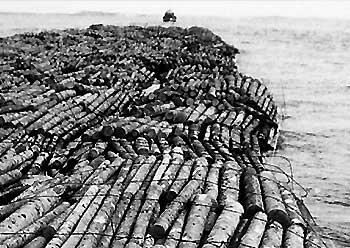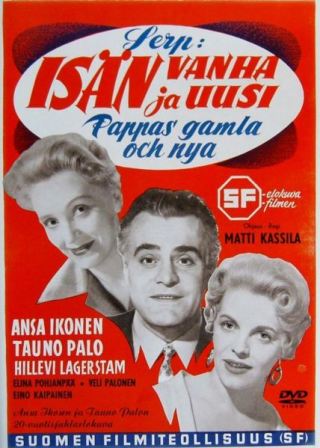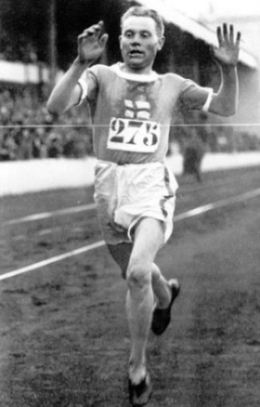6. From Dichotomy to Unification
Young Republic
After the Civil War, the nation was politically, economically, and collectively divided. President Ståhlberg actively pursued conciliatory politics for unifying the nation.
A number of laws were approved that contributed to the unification and improved the working class's conditions, such as giving amnesty to the Reds, allowing tenant farmers the possibility of buying the land they farmed, progressive taxation, conscription, the land acquisition law (Lex Kallio), relief for the poor, compulsory education, the labor agreement law, insurance for accidents, and the language law.
Municipal law was reformed in 1917 to guarantee general and equal voting rights for every 21-year-old citizen. The impact of the new laws was remarkable. They eased the atmosphere in the society, promoted equality, and supported economic growth.
The Improving Standard of Living
After the Civil War, Finland's economy rapidly started to grow. The 1929 global recession hit Finland as well, but it was weaker and shorter than in many other European countries. Super-inflation, massive unemployment, and economic crisis were avoided in Finland.
The gross production doubled in Finland between the two world wars. Products from the forest industry sector sold well in Europe. The most important export market was Great Britain. In the 1920s and 1930s, the forest industry accounted for 80-90% of Finland's total exports.

Timber rafting. The Forest industry started to grow in Finland in the 1920s.
After the depression in the 1930s, farming rapidly gained a high level of self-sufficiency. Sale of timber, logging, timber rafting, and the sawmill business generated additional incomes for the rural areas, where the standard of living was improving.
High duties protected the production of consumer goods in the home market. The state supported both farming-related enterprises and industrial production. The road and railroad networks were expanded. Income disparity between citizens decreased, narrowing differences in the society.
Art as a Consumer Good
The bloody civil war affected cultural dichotomy as well. In the 1920s and 1930s, dominant themes were nationalism, romantic nationalism, patriotism, tribalism, karelianism, modernism, and subjects related to the life of the proletariat and working class.
Key authors in the 1920s and 1930s were V.A. Koskenniemi, F.E. Sillanpää, Ilmari Kianto, L. Onerva, Katri Vala, Olavi Paavolainen, Mika Waltari and Toivo Pekkanen. In addition, the genres of music (Jean Sibelius, Aarre Merikanto), sculpture (Wäinö Aaltonen), painting (Tyko Sallinen) and architecture (Alvar Aalto) all went through a strong development phase.
The Power of Entertainment
When the national public service radio corporation Yleisradio was established in 1926, public radio transmissions started in Finland. The programming favored arts and cultural topics. In the 1930s, entertainment took over the daily programming.
Popular culture was entering Finland as Finns now could afford audio records and movies. The movie Siltalan pehtoori (1934), directed by Risto Orko, was viewed by a million Finns. The population of Finland was about 3.5 million at the time. The most popular Finnish film stars, Tauno Palo and Ansa Ikonen, were the first national celebrities.

"Father's new and old". A movie poster in 1955.
People liked to spend time at sports events as well. Paavo Nurmi and Ville Ritola were heroes for the sports fans. Finland was one of the top countries in the Olympics from 1920 to 1936, improving the national self-esteem. The dichotomy of the nation, however, was evident in sports as well. The working class had its own sports organization, called The Finnish Workers’ Sports Federation (Työväen Urheiluliitto). The Finnish Gymnastics and Sports Federation (Suomen Valtakunnan Urheiluliitto) assembled athletes from other classes.

Long-distance runner Paavo Nurmi (1897 – 1973).
Left and Right Wing Radicalism
After the civil war, political parties reorganized themselves. In the 1920s, domestic politics was inconsistent. Majority governments couldn't be formed, weakening the parliamentary system.
Supporters of monarchy founded the National Coalition Party (Kansallinen kokoomuspuolue) in 1918. The values of the party were nationalism and conservatism. Supporters of the republic established the liberal National Progressive Party (Kansallinen edistyspuolue). The Agrarian Party (Maalaisliitto) represented people employed in farming. The Swedish People's Party of Finland (Ruotsalainen kansanpuolue) was focused on language issues. The working class' Social Democratic Party of Finland (SDP) distanced itself from revolutionary ideas, focusing on parliamentary work.
Left wing radicals established the Communist Party of Finland (SKP, Suomen kommunistinen puolue) in Moscow. Its goal was an armed revolution. The party was banned in Finland. Communists used the Finnish Socialist Workers' Party (Suomen sosialistinen työväenpuolue) as their cover organization. The party was disbanded as treasonable in 1923, but communists continued as an organization that still participated in elections.
The communists infiltrated the labor union, organized large strikes, and raised revolutionary feelings among the working class. They couldn't reach large masses, clipping the wings of their uprising. Repeatedly, the number of votes in parliamentary elections was low. Soviet-Russia supported Finnish communists. In exchange for the aid, information about Finland's road and communications networks were passed on.
Expand Finland, Liberate Viena
The right wing dreamed of occupying East Karelia, liberating kindred people from communism. Even though kinship wars didn't materialize due to the enormous power of the Soviet-Russia, the Academic Karelia Society (AKS, Akateeminen Karjala-Seura),which supported the concept of Great Finland and hatred of Russians, promoted the tribal movement.

Academic Karelia Society operated from 1922 to 1944.
These 100,000 man strong civil-guard troops, originating from the White side of the civil war, were supported by the state. Women got their own civil-guard organization, Lotta Svärd, in 1921. Left wing supporters were refused admittance in national defense organizations.
In the 1930s, school curriculums promoted conservative values. Conservatives were regularly appointed to police and teacher positions. Organization of the police was managed by Whites. The military force highlighted the values of White Finland in its training. Left wing activities were closely monitored in the media, and the government actively tried to disband the communist organization. Employers established an association called Vientirauha (Peace for Export) that employed strikebreakers to end strikes.
Lapua Movement
In November 1929, communist youth presented a play in Lapua that ridiculed conservatives. Local civil guards were infuriated, tearing the actors' red shirts apart. The event was the starting point for a radical right wing movement, called the Lapua movement.
The leader of the movement was Vihtori Kosola. Left wing supporters were pressured to give up their confidential posts. They were assaulted, and driven toward their "dream state" behind the eastern border of Finland. Violence culminated in an event in which the movement drove former President K.J. Ståhlberg and his wife close to the eastern border. This event marked the downward trend for the movement's support.
The Lapua movement's mission was to make communism illegal. In the summer of 1930, the movement organized a so-called Peasant March in Helsinki that was attended by 12,000 men. Under pressure from the movement, President Relander appointed a new government and disbanded the Parliament. During the same year, the new Parliament approved the so called communist laws that illegalized communist activity in Finland.

The Peasant March organized by the Lapua movement, in Helsinki in 1930.
The story of the Lapua movement ended in the mutiny of Mäntsälä in 1932. Armed supporters of the movement surrounded the local community hall, interrupting an event held by Social Democrats. Armed rebels, entrenched in the community hall, demanded the resignation of the government.
The mutiny ended after President Svinhufvud gave a speech on the radio. The leaders were apprehended, and the Lapua movement was disbanded. The Patriotic People's Movement (IKL, Isänmaallinen Kansanliike), which was influenced by fascists in Germany and Italy, followed the same path.

President P.E. Svinhufvud (1861 - 1944).
Ostrobothnia was the core support region for the Lapua movement. The original mission of the movement was to ensure the rule of the Whites.They had minimal confidence in quarreling political parties, and lack of trust in national unification politics. Many were afraid of the increasing power of the working class, and the disintegration of their own life style. These fears were boosted by industrialization, urbanization, recession, and foreclosures of farms.
In the 1930s, Finland took actions to restrict the activities of radical movements. Military associations and provocative signs, such as the swastika and red flags were forbidden at public events. In the mid-1930s, the relationship between the working class and moderate conservatives slowly improved as the Agrarian Party and Social Democrats continued their unification politics.
Foreign Policy in the 1920s and 1930s
After the declaration of independence, the key objectives for Finland's foreign policy were neutrality and seeking protection from Soviet-Russia.
In the 1920s, Finnish volunteer soldiers were inspired by the idea of a Greater Finland. This nationalistic idea was to assert Finnish control over the areas inhabited by people related to Finns, like Karelians. Kinship wars strained the relationships with this eastern neighbor. Border conflicts between the countries were settled in the Tartu Peace Treaty in 1920, but the agreement didn't dispel mutual suspicions. An initiative for common defense with Poland, Estonia, and Latvia fell through.
In 1920, Finland joined the League of Nations that had been established to prevent conflicts like the First World War. Finland's relationship with Sweden was nervous because the county of Åland, an archipelago, wanted to join Sweden. In 1921, the League of Nations decided that Åland is part of Finland. Åland was granted autonomy and declared as a demilitarized zone.

Since 1921, Åland has been autonomous.
In the early 1930s, Finland tried to co-operate with Nordic countries in order to enhance security, but Sweden wanted to remain neutral. The rise of the Nazis, Germany's resignation from the League of Nations, and its rearming activities worried Finland's leaders. Since Finland wanted to improve its relations with the Soviet Union and it wanted to secure its western border, the two states signed a non-aggression pact in 1932.